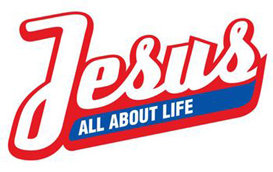
Over the past weeks, I've been brainstorming topics to kick-start 2010 with. I won't list them but I'll say (to the relief of some) that I intend on harping less about social media and more about other 'things'. I'm not going to dump social media (a bad move, considering it's increasing dominance in the current online world), but I'll be mixing things up.
Having said that, I've selected this article from Mumbrella to christen my blog for 2010 (all puns intended). Why?
- The differentiation factor- Not many bloggers in the online strategy/advertising arena blog about religion. Why? Because it isn't sexy (or the trending topic)...or maybe there just isn't enough traffic (or dollars) in religion to attract enough attention. I mean what'd you prefer to blog (and read) about? God or Gowalla, and it's geolocation deliciousness?
- The takeaway - After digging into this campaign, I've hit on some insights, which I've personally benefited from, and which I believe are applicable for all organisations, great and small.
I intend on breaking up my analysis of this campaign into two blog posts. The first post will provide an overview of the campaign, and what I've learnt from the campaign. The second post will be a list of recommendations to the master puppeteers behind the Jesus All About Life Campaign, which can be implemented for JAAL 2.0 (if there will be such a thing).
The following sections provide a summary of the Jesus All About Life campaign. If you want to skip it, jump to the section titled "What have I learnt from this Case Study" and read on. The juicy stuff will be there :)
So what is Jesus All About Life (JAAL)?
The Mumbrella article has summed it up pretty well and a more detailed explanation can be found at the JAAL website, but here's JAAL in a nutshell:
- It's a mass media movement (television, print, broadcast, internet) developed by Australian independent creative agency, 303.
- The campaign ran from Sept 15, 2009 for 6 weeks, across NSW & WA.
- The campaign is non-denomational - Anglicans/Baptists/Catholics/etc alike cooperate and work towards common goals.
- Total media buy in : ~ $1.5 million
What were the campaign goals?
- Increase the public's awareness of Jesus (and what he said about life). (Note the goal was not to convert the public).
- Get the churches in the advertising target area, active.
What advertising channels were involved in this campaign?
I've identified 5 main channels:
- INTERNET
- TELEVISION
- Campaign Commerical
- PRINT MEDIA
- BROADCAST (RADIO)
- OTHER
- Gen Y says Thankyou BBQ
- Skywriting
- Jesus Racing Team
- City2Surf Jesus All About Life Team
- Campaign Prize Giveaways (2 exclusive tickets to the Supercheap Auto Bathurst 1000)
- Public Talks
- Andrew Fisher, from Jesus Racing, talked to the detainees at the Reiby Juvenile Justice Centre.
- Mark Scott's, Managing Director ABC, presentation to Christian business people.
This list has been generated from my own tracking of the campaign. A more detailed list of media mentions can be found in the JAAL Media Room, under the 'JAAL Media Monitor' section.
WHAT HAVE I LEARNT FROM THIS CASE STUDY?
- The traditional media marketing platform is evolving
The August 09 Media Report (slide 2), details that Internet claimed the largest media coverage (33%), compared to other media channels: Newspaper (27%), Magazine (20%), Broadcast (18%) and Television (2%). I believe this is just one sign that the traditional media marketing platform is evolving , and there are two main reasons for it:
i. The people (users) of today demand constant, poly-directional real-time engagement. Users require many channels of interaction with the content or platform they are dealing with. This type of interaction isn't as readily provided by traditional marketing means which tend to be more uni-directional. However, the Internet is able to support this communication model and this is what makes social media web technologies such as Twitter, YouTube and Facebook so popular. Don't believe me? According to Pete Cashmore, CEO of Mashable, real-time communication will only increase even more next year.This following statistic, which surprised me greatly, also supports my idea that the traditional media marketing platform is evolving: "60% of tv watchers in the USA have a laptop with them at the time." (via @markc at the Future of Technology in Entertainment Event, Sydney). Perhaps this is the start for a different approach to advertising, blending the real-time online environment with the time old television box. Perhaps this form of 'fusion advertising' will be even more effective than the advertisements that are purely designed for television or solely crafted for the Internet.
ii. The internet can be leveraged at low cost.Twitter, Facebook, YouTube, etc. involve no major initial/operational costs...unlike television and radio. Advertising space on the traditional channels are extremely expensive. Unless you have deep pockets to burn holes through, I'd consider advertising online. - The public perpetuates publicity. Once the campaign is launched, the public will talk about it, no matter what. Whether it’s positive or negative, in the blogosphere or in the twitosphere, it will be talked about. This is important to remember because what it means is that all you need to do is to nudge your campaign into the public arena. The public will sweep it away. This means that the amount of time, effort and money thrown into manufacturing the marketing campaign really only needs to be condensed at the start. Once it’s out there, the campaign only needs to be monitored and measured.
- Most humans have memories like goldfish. I may be wrong in saying this, but I still believe, most humans (including myself) have memories like goldfish. Why do I believe this? We are bombarded with so many advertisements, to the point where only a low percentage of advertisements are actually remembered. These advertisements are what we call 'sticky' advertisements, i.e. campaigns that have impacted the audience so much so that they are still remembered even after the campaign's termination.I think it'll be interesting to listen and measure the traffic surrounding the 'Jesus All About Life' campaign, across different online channels (Twitter, YouTube, Facebook, blogs, discussion boards, etc) over the following months to see if the campaign has persisted after its operational period. The Mumbrella article referred to earlier was published approximately 4 months after the campaign terminated. Is this enough show the campaign has persisted? No, most likely not. But it's pretty cool that Mumbrella picked it up. So...was the 'Jesus All About Life' campaign a 'sticky' campaign?
- Budget is a limiting factor, only if you let it so. This point may be slightly contentious, but I'm going to throw it out there. If there's one thing we can takeaway from this case study, it's that budget isn't always proportional to campaign success. 303 has done a remarkable job in delivering a campaign that is on par with some of the industry's best. This statement bares even more weight when you consider that the subject matter, Jesus, is a topic that isn't easy to sell. I personally believe that using a low/tight budget as a reason for a failed/unsuccessful campaign is one excuse for poor creativity. This statement, I believe, is extremely relevant to the online industry, where web technology can be utilised at minimal cost. As such, the real limiting factor is what you can do with the technology, i.e. your creativity. As I said...a point that's slightly contentious :P
Well this basically wraps up Part 1 of my case study on the Jesus All About Life Campaign. I'm keen to hear what others have to say on the matter, and even on some of the ideas I've raised.
Stay tuned for Case Study: Jesus All About Life, Part II, where I'll be making some recommendations that are economic, realistic and easy to implement.
